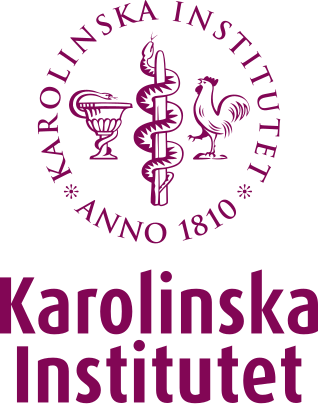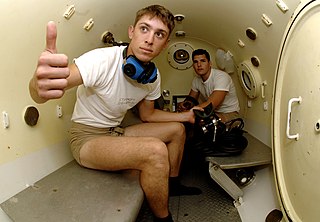
Medical physics is, in general, the application of physics concepts, theories, and methods to medicine or healthcare. Medical physics departments may be found in hospitals or universities.

The Karolinska Institute is a research-led medical university in Solna within the Stockholm urban area of Sweden. It covers areas such as biochemistry, genetics, pharmacology, pathology, anatomy, physiology and medical microbiology, among others. It is recognised as Sweden's best university and one of the largest, most prestigious medical universities in the world. It is the highest ranked in all Scandinavia. The Nobel Assembly at the Karolinska Institute awards the Nobel Prize in Physiology or Medicine. The assembly consists of fifty professors from various medical disciplines at the university. The current rector of Karolinska Institute is Ole Petter Ottersen, who took office in August 2017.

The National Institute for Occupational Safety and Health is the United States federal agency responsible for conducting research and making recommendations for the prevention of work-related injury and illness. NIOSH is part of the Centers for Disease Control and Prevention (CDC) within the U.S. Department of Health and Human Services.
Occupational noise is the amount of acoustic energy received by an employee's auditory system when they are working in the industry. Occupational noise, or industrial noise, is often a term used in occupational safety and health, as sustained exposure can cause permanent hearing damage.
Sports science is a discipline that studies how the healthy human body works during exercise, and how sport and physical activity promote health and performance from cellular to whole body perspectives. The study of sports science traditionally incorporates areas of physiology, psychology, anatomy, biomechanics, biochemistry and biokinetics. Sports scientists and performance consultants are growing in demand and employment numbers, with the ever-increasing focus within the sporting world on achieving the best results possible. Through the study of science and sport, researchers have developed a greater understanding on how the human body reacts to exercise, training, different environments and many other stimuli.

Diving medicine, also called undersea and hyperbaric medicine (UHB), is the diagnosis, treatment and prevention of conditions caused by humans entering the undersea environment. It includes the effects on the body of pressure on gases, the diagnosis and treatment of conditions caused by marine hazards and how relationships of a diver's fitness to dive affect a diver's safety.
David Platt Rall was a cancer specialist and a leader in environmental health studies, whose work in environmental health helped turn it into a scientific discipline. Rall also advanced public health and prevention. He directed the National Institute of Environmental Health Sciences from 1971 to 1990, year in which he retired. His work on toxicology and carcinogenesis was recognized by his appointment as the first director of the National Toxicology Program in 1978. He held the rank of Assistant Surgeon General in the United States Public Health Service. He also chaired the World Health Organization's Program on Chemical Safety.

The Florey Institute of Neuroscience and Mental Health, more commonly known as the Florey Institute, is an Australian medical research institute that undertakes clinical and applied research into treatments for brain and mind disorders and the cardiovascular system. The Institute's areas of interest include Parkinson's disease, stroke, motor neurone disease, traumatic brain and spinal cord injury, addiction, epilepsy, multiple sclerosis, brain development in premature babies, Huntington's disease, depression, schizophrenia, brain function in health and disease, heart failure, and dementia.
A health professional may operate within all branches of health care, including medicine, surgery, dentistry, midwifery, pharmacy, psychology, nursing or allied health professions. A health professional may also be a public/community health expert working for the common good of the society.
Eula Bingham is an American scientist who is best known as an Assistant Secretary of Labor for Occupational Safety and Health during the Presidency of Jimmy Carter.

The Kaohsiung Medical University is a private university located in Sanmin District, Kaohsiung, Taiwan.
Occupational medicine, until 1960 called industrial medicine, is the branch of medicine which is concerned with the maintenance of health in the workplace, including prevention and treatment of diseases and injuries, with secondary objectives of maintaining and increasing productivity and social adjustment in the workplace.

2-Heptanone, also known as methyl n-amyl ketone, or Heptan-2-one, is a ketone with the molecular formula C7H14O. It is a colorless, water-like liquid with a banana-like, fruity odor. 2-Heptanone has a neutral formal charge, and is only slightly soluble in water.

Occupational stress is stress related to one's job. Occupational stress often stems from unexpected responsibilities and pressures that do not align with a person's knowledge, skills, or expectations, inhibiting one's ability to cope. Occupational stress can increase when workers do not feel supported by supervisors or colleagues, or feel as if they have little control over work processes.
The West Virginia University School of Medicine is the professional school for the study of medicine and other health professions at West Virginia University in Morgantown, West Virginia. The medical school was established in 1902 as the first such institution in the state of West Virginia. It remains one of only three medical schools in the state.

Occupational safety and health (OSH), also commonly referred to as occupational health and safety (OHS), occupational health, or workplace health and safety (WHS), is a multidisciplinary field concerned with the safety, health, and welfare of people at work. These terms also refer to the goals of this field, so their use in the sense of this article was originally an abbreviation of occupational safety and health program/department etc.

Isaac Mikhailovich Trachtenberg - Ukrainian and Soviet hygienist, Professor, MD, a member of the National Academy of Sciences of Ukraine, academician of the Bogomolets National Medical University, Honored Worker of Science and Technology of Ukraine (1994), winner of the state Prize of Ukraine (2002). Bogomolets (2010, academic awards for Preventive Medicine of the National Academy of Medical Sciences of Ukraine.
Birger Tvedt was a Norwegian sports medical and physiotherapist also known as the "Biggen". He was the son of a deacon Sigvard Andreas Tvedt (1876–1965) and Martha Carens Kruse (1882-1966) and married to physical therapist Inger Torgersen. He was nephew to the pastor Just Kruse (1886–1962), and cousin to Colonel Erling O. Kruse and physiotherapists Astrid E. Kruse Andersen.
Occupational epidemiology is a subdiscipline of epidemiology that focuses on investigations of workers and the workplace. Occupational epidemiologic studies examine health outcomes among workers, and their potential association with conditions in the workplace including noise, chemicals, heat, or radiation, or work organization such as schedules.










